Farm & Ranch
[AgriLife Today] Texas barbecue owners, pitmasters learn about price trends at town hall meeting
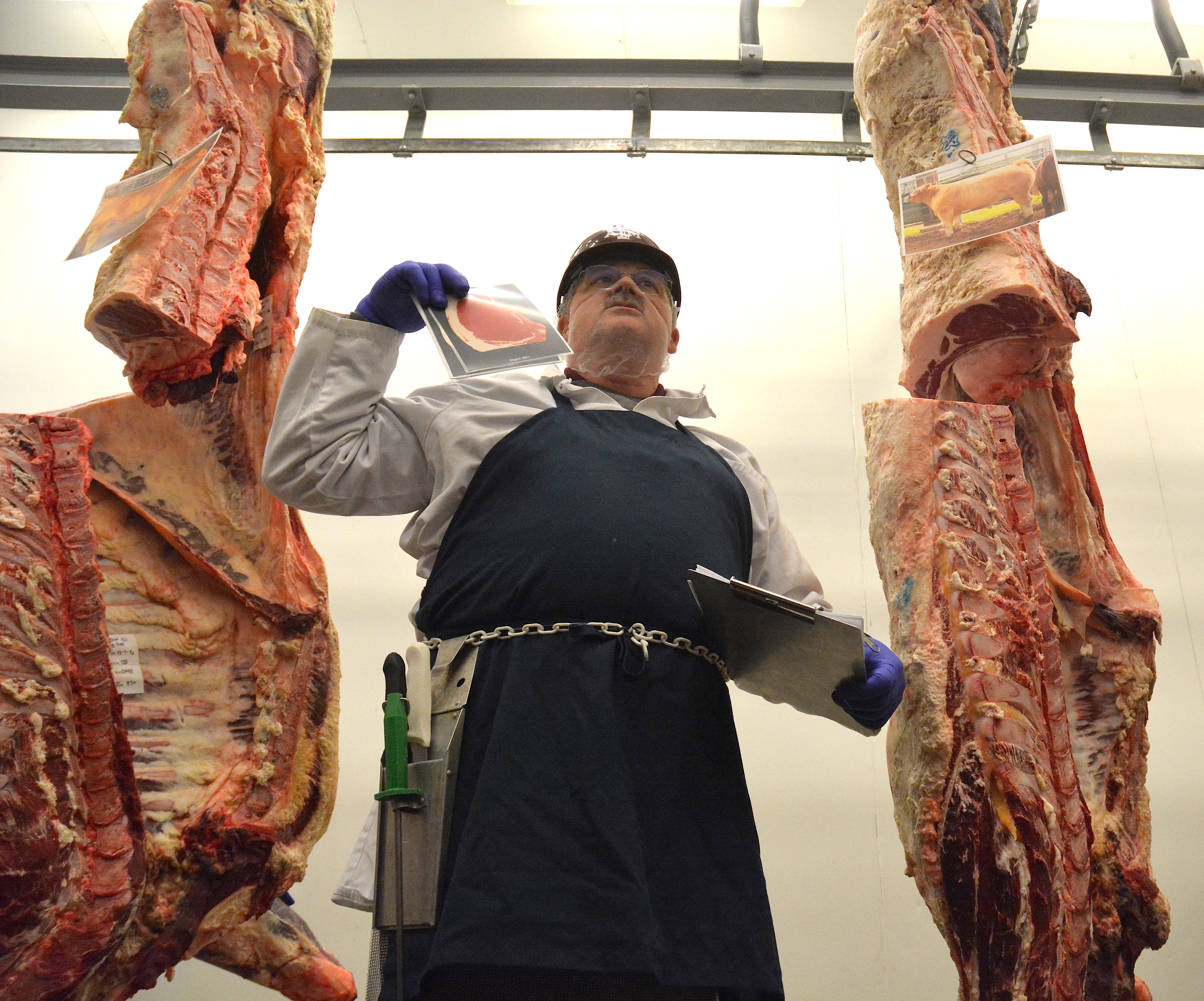
By: Blair Fannin
Beef, poultry, pork projected to continue record production levels
Writer: Blair Fannin, 979-845-2259, [email protected]
Contact: Dr. Jeff Savell, 979-845-3992, [email protected]
COLLEGE STATION – Record pounds of beef, pork and poultry produced in 2016 are projected to reach even higher in 2017, making Texas barbecue owners feel good about their prospects for satisfying hungry customers.
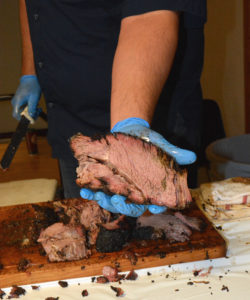
Evan LeRoy, pitmaster from Austin, cooked barbecue beef chuck roll for participants at the Texas Barbecue Town Hall meeting held at Texas A&M University in College Station. (Texas A&M AgriLife Extension Service photo by Blair Fannin)
“I think there will be more production of beef cows nationally and that will keep brisket prices down (as we head into 2017),“ said David Anderson, Texas A&M AgriLife Extension Service livestock economist, College Station. “We are coming off record cattle prices in 2015 and there’s expansion of the cow herd. With expansion comes lower prices.”
Texas barbecue restaurant owners and pitmasters heard Anderson give meat price and supply forecasts for 2017 at the recent Texas Barbecue Town Hall meeting at Texas A&M University in College Station. Dr. Kerri Gehring, associate professor of meat science in the animal science department, College Station, gave a food safety update.
The meeting, attended by 45 participants, was organized by Dr. Jeff Savell, university distinguished professor, Regents Professor and E.M. “Manny” Rosenthal chairholder in the department of animal science at Texas A&M in College Station. He was joined by Dr. Davey Griffin, AgriLife Extension meat specialist, and Ray Riley, manager of the Rosenthal Meat Center, both based in College Station, who led participants through a meat cooler, demonstrating carcass yield grades, barbecue beef cuts and potential carcass cuts that could be used as barbecue menu options.
“Last year we grew beef production by 3.5 percent,” Anderson said. “For 2017, we think we will have even more cows by the time the U.S. Department of Agriculture inventory report comes out in January.”
Low corn prices has helped feedlot operators add more gain. That, in turn, has led to higher levels of beef production and cheaper prices for wholesale brisket versus 2015 levels. Historic high cattle prices drove up prices for beef brisket, which in turn caused barbecue restaurant owners to raise their prices to offset their rising overhead costs.
Now that those prices have come down, it has helped improve bottom lines, but some participants still expressed concern.
“But if there’s a drought, all of this could get thrown out, right?” said Russell Roegel of Roegels Barbecue in Houston.
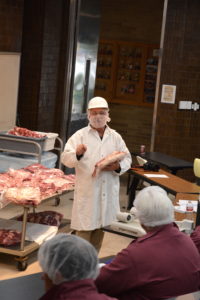
Dr. Jeff Savell, university distinguished professor, Regents Professor and E.M. “Manny” Rosenthal chairholder in the department of animal science at Texas A&M University, discusses beef cuts at the recent Texas Barbecue Town Hall meeting. (Texas A&M AgriLife Extension Service photo by Blair Fannin)
Anderson said, “If there’s a drought, but not widespread, it will certainly slow down the rate of growth in weight, but it wouldn’t be enough to slow down the trend we have right now of expansion.”
Kent Black of Black’s Barbecue in Lockhart wanted to know if corn prices would stay at or around current levels.
“I think so,” Anderson said. “To get a real big spike we would have to get a really big drought that was widespread. Cheap corn prices are going to feed further expansion.”
Evan LeRoy, pitmaster from Austin, cooked barbecue beef chuck roll and pork brisket for the town hall participants, which was a bit different than traditional barbecue, he said.
“I wanted to show that there are lots of other different barbecue cuts besides ribs and sausage,” LeRoy said.
To learn more about the Texas A&M barbecue program, visit bbq.tamu.edu .
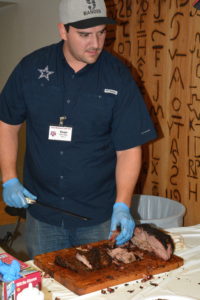
Evan LeRoy, pitmaster from Austin, cooked barbecue beef chuck roll and pork brisket for participants at the Texas Barbecue Town Hall meeting held at Texas A&M University in College Station. (Texas A&M AgriLife Extension Service photo by Blair Fannin)
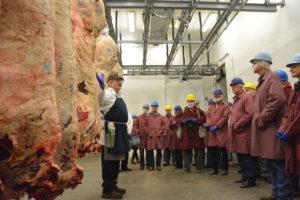
Dr. Davey Griffin, Texas A&M AgriLife Extension Service meat specialist, College Station, discusses beef yield grade and carcass cuts at the Texas Barbecue Town Hall meeting recently at Texas A&M University in College Station. (Texas A&M AgriLife Extension Service photo by Blair Fannin)
-30-
Find more stories, photos, videos and audio at http://today.agrilife.org
Farm & Ranch
Acorn Toxicity

By Barry Whitworth, DVM, MPH
With the prolonged drought, most pastures in Oklahoma end up in poor condition. With the lack of available forage, animals may go in search of alternative foods.
If oak trees are in the pastures, acorns may be a favorite meal for some livestock in the fall. This may result in oak poisoning.
Oak leaves, twigs, buds, and acorns may be toxic to some animals when consumed.
To read more, pick up a copy of the November edition of North Texas Farm & Ranch magazine, available digitally and in print. To subscribe by mail, call 940-872-5922.

Farm & Ranch
Silver Bluestems

By: Tony Dean
There are a handful of grasses on North Texas grazing lands ranchers need to know, not because they are highly desirable, but rather because they are not of much value. I call them “decom” plants, which is am acronym for “Don’t Ever Count On Me.” Silver bluestem is a “decom” grass.
Silver bluestem is a perennial which grows in all areas of Texas. It can survive in almost all soil types, and in full sun conditions or in semi shade. It grows up to three feet tall and is easily recognized with the presence of the white fuzzy seed head. Also, one of the identifying characteristics of Silver bluestem is a bend in the stems at each node, causing the plants to take on a rounded shape as they mature.
To read more, pick up a copy of the November edition of North Texas Farm & Ranch magazine, available digitally and in print. To subscribe by mail, call 940-872-5922.

Farm & Ranch
Meanwhile Back At The Ranch

By: Rayford Pullen
Fall is here which means winter is closing in on us and before we officially get into winter, we need to make sure our factories are either producing or will be producing in a few months.
We have been pregnancy testing our cows this fall and if they are not bred or nursing a calf, we are bidding them adios. With annual costs somewhere between $900.00 and $1,000.00 per cow, those cows not producing a live weaned calf are costing us quite a bit.
To read more, pick up a copy of the November edition of North Texas Farm & Ranch magazine, available digitally and in print. To subscribe by mail, call 940-872-5922.
-

 Country Lifestyles2 years ago
Country Lifestyles2 years agoScott & Stacey Schumacher: A Growth Mindset
-

 Country Lifestyles8 years ago
Country Lifestyles8 years agoStyle Your Profile – What your style cowboy hat says about you and new trends in 2017
-

 HOME8 years ago
HOME8 years agoGrazing North Texas – Wilman Lovegrass
-

 Equine1 year ago
Equine1 year agoThe Will to Win
-

 Country Lifestyles5 years ago
Country Lifestyles5 years agoAmber Crawford, Breakaway Roper
-

 Outdoor9 years ago
Outdoor9 years agoButtercup or Primrose?
-

 Country Lifestyles8 years ago
Country Lifestyles8 years agoJune 2016 Profile – The man behind the mic: Bob Tallman
-

 Country Lifestyles8 years ago
Country Lifestyles8 years agoDecember 2016 Profile, Rusty Riddle – The Riddle Way




